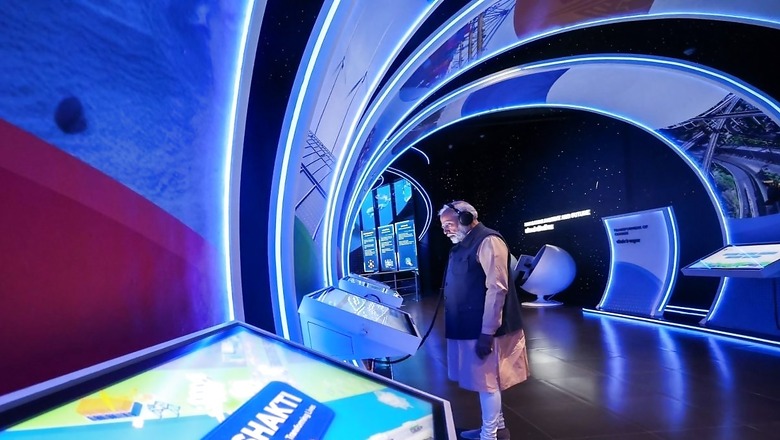
views
The PM Gati Shakti National Master Plan (NMP) for multi-modal connectivity was launched by Prime Minister Modi on October 13, 2021, and marked its third anniversary last Saturday. Over the past three years, Modi’s Gati Shakti NMP has accelerated India’s journey towards achieving the goal of a Viksit Bharat by enhancing multimodal connectivity. From technology to transport and logistics, and from power to human resources, the NMP has integrated the nation’s multi-sectoral prowess to position Bharat as the most vibrant and attractive economic destination.
Gati Shakti has played a critical role in adding momentum to India’s infrastructure development. It utilises technology effectively to ensure projects are completed on time and potential challenges are mitigated. The NMP has emerged as a transformative initiative aimed at revolutionising India’s infrastructure. The seamless integration of various stakeholders has led to improved logistics, reduced delays, and the creation of new opportunities for many people.
Here are the key ways in which it is transforming the nation:
(1) Geospatial Intelligence for Smarter Planning and Monitoring: Utilising real-time data from GIS and satellite imagery, Gati Shakti provides data-driven insights for more informed decision-making and enables early detection of potential issues. This represents the future of infrastructure development in India, both in terms of planning and execution.
(2) Smart Logistics for Enhanced Efficiency: The Unified Logistics Interface Platform (ULIP) is designed to improve efficiency, transparency, and coordination within the logistics sector.
(3) Breaking Silos for a Collective Vision: The Network Planning Group (NPG) is synchronising efforts across ministries to ensure cohesive infrastructure development. So far, 81 NPG meetings have been held, evaluating 213 projects worth Rs 15.48 lakh crore.
(4) Unified Data Platform: The portal hosts 1,529 data layers from 44 central ministries (641 layers) and 36 states/UTs (888 layers). Notably, 16 states/UTs have uploaded over 80 per cent of their mandatory data layers, enhancing transparency and collaboration.
(5) Revolutionising Project Planning: With digital surveys, project preparation is now faster and more accurate. In just a year, the Ministry of Railways has planned over 400 railway projects covering 27,000 km of railway lines. Additionally, the Ministry of Tribal Affairs has mapped 45 lakh PVTGs across 29,000 habitations using a mobile app with more than 1,500 GIS layers. The Ministry of Women and Child Development is leveraging PMGS for the effective planning of Anganwadi Centres.
(6) ‘Whole-of-Government’ Approach: This initiative involves 44 central ministries and 36 states and Union Territories for coordinated project execution. So far, 156 infrastructure gaps have been identified by relevant ministries and departments, paving the way for comprehensive development.
(7) Multimodal Connectivity: By integrating highways, railways, ports, airports, mass urban transportation, and inland waterways, this initiative ensures the seamless movement of goods. It addresses supply chain bottlenecks and enhances the competitiveness of Indian industries.
(8) Smart Green Solutions for Sustainable Infrastructure: PM Gati Shakti is fostering a green and sustainable logistics network, promoting environmental responsibility and aligning with national climate goals, contributing to a cleaner, greener future for India.
Clearly, Gati Shakti is a groundbreaking initiative that is making India’s infrastructure smarter and more integrated, driving economic growth and shaping the future of development. Plans are underway to take the PM Gati Shakti scheme global, with discussions in progress with several countries, including Nepal, Bangladesh, Sri Lanka, Madagascar, Senegal, and Gambia. The Modi government is also considering granting non-government players access to non-sensitive shareable data relevant to infrastructure project planning. This access will be provided in a secure manner. So far, around 208 infrastructure projects involving multiple ministries, including roads and railways, worth over Rs 15 lakh crore, are at various stages of approval.
PM Gati Shakti has introduced a paradigm shift in how India plans and executes infrastructure projects. By integrating data from multiple ministries and states, the Modi government has created a more efficient, transparent, and outcome-driven system. The results are evident in faster project execution, reduced logistical costs, and improved services reaching every corner of the country. All 36 states and Union Territories have developed PM Gati Shakti State Master Plan (SMP) portals, aligned with the PM Gati Shakti NMP platform, to synchronise infrastructure assets and boost regional development.
PM Gati Shakti is based on six key pillars:
(a) Comprehensiveness: It includes all the existing and planned initiatives of various ministries and departments within a single, centralised portal. Each department now has visibility into the activities of others, providing crucial data for the comprehensive planning and execution of projects.
(b) Prioritisation: This enables different departments to prioritise their projects through cross-sectoral interactions.
(c) Optimisation: The National Master Plan helps various ministries plan projects by identifying critical gaps. For goods transportation, it aids in selecting the most optimal route in terms of time and cost.
(d) Synchronisation: Ministries and departments often work in silos, leading to delays due to a lack of coordination in planning and implementation. PM Gati Shakti ensures synchronisation of activities across departments and different layers of governance, promoting cohesive and coordinated project execution.
(e) Analytical: The plan consolidates all data in one place, using GIS-based spatial planning and analytical tools with over 200 layers, enabling better visibility for executing agencies.
(f) Dynamic: All ministries and departments are now able to visualise, review, and monitor the progress of cross-sectoral projects via the GIS platform. Satellite imagery periodically provides updates on the ground, and the progress of projects is regularly updated on the portal. This helps identify key interventions for enhancing and updating the master plan.
Traditionally, there was a lack of coordination between departments. For instance, after a road was constructed, other agencies would later dig it up for tasks such as laying underground cables or gas pipelines. This not only caused significant inconvenience but also led to wasteful expenditure. To address this, efforts have been made to improve coordination, ensuring that cables, pipelines, and similar infrastructure are laid simultaneously. Additionally, steps have been taken to address issues like the lengthy approval process and the multiplicity of regulatory clearances.
In the last three years, the Modi government has placed unprecedented emphasis on infrastructure development through a holistic approach. This has addressed past challenges by institutionalising comprehensive planning for stakeholders involved in major infrastructure projects. Instead of planning and designing projects in silos, they are now being conceived and executed with a unified vision.
The Bharatmala Pariyojana, with an estimated cost exceeding Rs 10.64 lakh crore, showcases Prime Minister Narendra Modi’s ambitious Gati Shakti plan in full. The Bharatmala project has been steadily progressing towards the development of over 84,000 km of roads, including 26,000 km of economic corridors. Along with the Golden Quadrilateral (GQ) and the North-South and East-West (NS-EW) corridors, these routes are expected to handle the majority of freight traffic on Indian roads. Additionally, over 8,000 km of inter-corridors and over 7,500 km of feeder routes have been identified to enhance the effectiveness of the economic corridors, GQ, and NS-EW corridors.
The programme also envisions the development of ring roads, bypasses, and elevated corridors to decongest traffic in cities and improve logistical efficiency. So far, 28 cities have been identified for ring roads, and 125 choke points and 66 congestion points have been earmarked for improvement. Furthermore, to reduce congestion on the proposed corridors and enhance logistical efficiency while cutting freight costs, 35 locations have been identified for the development of multimodal logistics parks.
Sagarmala, another ambitious port-led development project under the umbrella of the Gati Shakti initiative, is estimated to save up to Rs 40,000 crore per annum by 2025. The project is reducing costs for both domestic and export-import (EXIM) cargo by promoting the movement of raw materials and finished goods through coastal shipping and inland waterways. This method is between 60 to 80 per cent cheaper than road and rail transport.
Additionally, the Sagarmala project aims to increase the share of inland waterways and coastal shipping in India’s modal mix from 6 per cent to 12 per cent. The cost of power generation is also expected to decrease by Rs 0.50 per unit due to this initiative. By enabling smooth and efficient coal transport via coastal routes, Sagarmala is projected to increase the movement of coal from 27 million tonnes per annum in 2016 to a substantial 129 million tonnes per annum by 2025.
Currently, for power plants located far from coal mines, coal logistics account for 35 per cent of the total cost of power production. Therefore, the Sagarmala project has been a game-changer in terms of reducing significant logistical and production costs.
It suffices to conclude that the PM Gati Shakti initiative represents a transformative approach to infrastructure development in India, aiming to create a seamless and efficient multimodal transportation network. By integrating the efforts of various ministries and leveraging advanced technologies, this initiative seeks to enhance connectivity and reduce logistics costs across the nation. The Gati Shakti Sanchar portal further supports this vision by streamlining the right-of-way approval process, accelerating the rollout of telecom infrastructure, and facilitating the rapid deployment of 5G services nationwide.
With these combined efforts, India is well-positioned to achieve its ambitious goals of Aatmanirbharta, as envisioned by Prime Minister Modi. The Gati Shakti project exemplifies the seamless blend of grand vision and effective execution under the Modi government, creating a vibrant whole. India has, notably, surpassed the US and has been repeatedly ranked as the second most sought-after manufacturing destination globally, according to firms like Cushman and Wakefield, particularly in sectors such as pharmaceuticals, chemicals, and engineering.
A strong and functional physical infrastructure, alongside an equally robust digital framework, plays a critical role in India’s emergence as a global manufacturing hub. Notably, Prime Minister Narendra Modi’s Gati Shakti project serves as the fulcrum around which India’s infrastructure growth story is rapidly evolving, acting as a force multiplier in numerous ways.
Sanju Verma is an Economist, National Spokesperson for BJP and Bestselling Author of “The Modi Gambit”. Views expressed in the above piece are personal and solely those of the author. They do not necessarily reflect News18’s views.


















Comments
0 comment